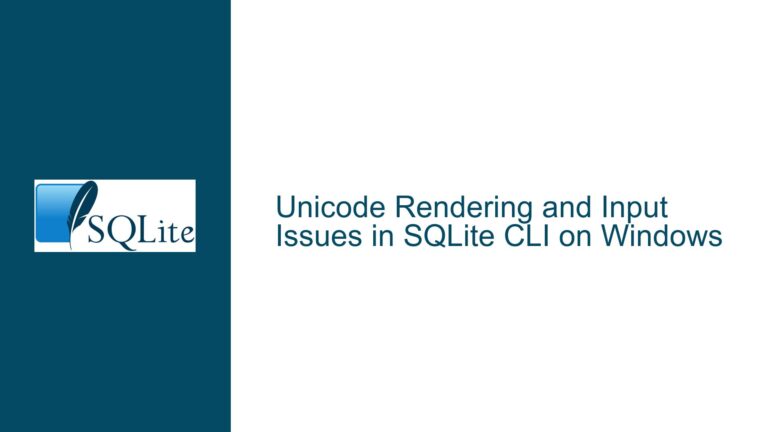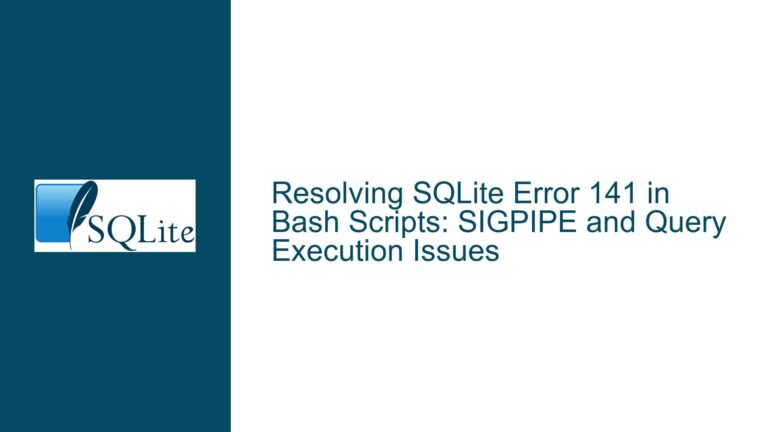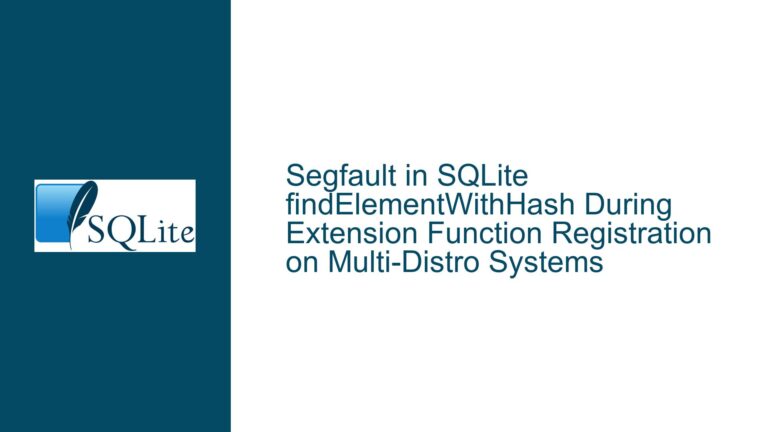Ensuring SQLite Database Integrity During Power Failures and Filesystem Concerns
Issue Overview: Database and Directory Corruption Risks During File Growth
SQLite is designed to provide robust ACID (Atomicity, Consistency, Isolation, Durability) guarantees, ensuring that database transactions are processed reliably even in adverse conditions. However, concerns arise when the database file grows dynamically (e.g., through page allocation) and a power failure or abrupt disconnection occurs during this process. The core issue revolves around whether such failures can corrupt both the database file and its parent directory, particularly on filesystems lacking journaling capabilities (e.g., FAT32 commonly used on USB drives).
This problem is not strictly a SQLite limitation but a broader interaction between the database engine, operating system I/O behavior, and filesystem design. SQLite relies on the filesystem to ensure metadata consistency (e.g., directory entries, file size updates). When a power failure interrupts a file extension operation, the risk of directory corruption depends on whether the filesystem guarantees atomic updates to its metadata. For example, FAT32 does not journal directory changes, making it susceptible to inconsistencies if a write operation is interrupted. SQLite mitigates database file corruption through its journaling or Write-Ahead Logging (WAL) mechanisms, but directory integrity depends on the underlying filesystem’s robustness.
Possible Causes: Filesystem Metadata Vulnerability and I/O Synchronization Gaps
1. Non-Journaling Filesystems (e.g., FAT32, exFAT):
Filesystems without journaling do not log metadata changes before applying them. When SQLite extends the database file size, the filesystem must update the directory entry to reflect the new file size. If power loss occurs mid-operation, the directory entry may be left in an inconsistent state. This can manifest as unreadable directory names, phantom files, or inaccessible paths. USB drives formatted with FAT32 are particularly prone to this due to their widespread use and lack of built-in metadata journaling.
2. Incomplete fsync() or FlushFileBuffers() Operations:
SQLite calls fsync() (or equivalent) on both the database file and its parent directory after extending the file. This ensures that all changes are flushed to disk. However, some operating systems or hardware configurations may not honor these synchronization requests correctly. For instance:
- Certain Linux kernel versions have had bugs where
fsync()on directories was ineffective. - Windows’ handling of removable media (e.g., USB drives) sometimes delays or skips metadata flushes for performance reasons.
If the directory’s metadata is not fully persisted, a power failure can leave it corrupted.
3. File Growth Without Preallocation:
When SQLite appends a new page to the database, the file size increases incrementally. Frequent small extensions increase the likelihood of an interruption occurring during a critical I/O operation. Preallocating space (e.g., reserving a large contiguous block upfront) reduces the frequency of file size changes, thereby minimizing exposure to metadata updates.
Troubleshooting Steps, Solutions & Fixes: Mitigating Corruption Risks
1. Use a Journaling Filesystem:
Reformat the storage device with a journaling filesystem such as ext4 (Linux), NTFS (Windows), or APFS (macOS). These filesystems log metadata changes in a journal before committing them, allowing recovery to a consistent state after power loss. For example, on Linux:
mkfs.ext4 /dev/sdX
Note: USB drives formatted as NTFS may have reduced compatibility with non-Windows devices. Consider exFAT for cross-platform use, though it lacks journaling.
2. Preallocate Database File Space:
Create a fixed-size database file upfront to avoid dynamic growth. SQLite will fill preallocated pages as needed, reducing filesystem metadata updates. On Linux, use fallocate; on Windows, use fsutil:
fallocate -l 1G database.db # Linux
fsutil file createnew database.db 1073741824 # Windows (1 GiB)
After preallocation, configure SQLite to use the entire space:
PRAGMA schema.page_size = 4096;
PRAGMA schema.max_page_count = 262144; -- For 1 GiB
VACUUM; -- Reorganize to apply settings
3. Enable Write-Ahead Logging (WAL) Mode:
WAL mode reduces the frequency of directory synchronization by deferring writes to a separate log file. This minimizes direct interactions with the main database file during transactions:
PRAGMA journal_mode = WAL;
Advantages:
- Fewer
fsync()calls on the directory. - Concurrent reads and writes are supported.
Caveats: - WAL requires the
-waland-shmfiles to coexist with the database. Ensure the filesystem handles temporary files robustly.
4. Verify OS and Filesystem fsync() Behavior:
Test whether your OS correctly synchronizes directory metadata. On Linux, use strace to monitor fsync() calls:
strace -e trace=fsync sqlite3 test.db "INSERT INTO data VALUES (...);"
Look for fsync calls on both the database file and its directory. If absent, consider mounting the filesystem with stricter synchronization options:
mount -o sync,dirsync /dev/sdX /mnt/usb
The dirsync option ensures directory updates are synchronous.
5. Hardware and Configuration Adjustments:
- Use UPS (Uninterruptible Power Supply): Mitigate power failure risks entirely.
- Disable Write Caching on Removable Drives: On Windows, open Device Manager → Disk Drives → Properties → Policies → “Better performance” → Uncheck “Enable write caching”.
- Avoid USB Hubs: Directly connect the storage device to minimize disconnection risks.
6. Periodic Integrity Checks:
Regularly verify database and filesystem health:
sqlite3 database.db "PRAGMA integrity_check;" # SQLite integrity check
chkdsk /f E: # Windows filesystem check
fsck /dev/sdX # Linux filesystem check
7. Fallback to TRUNCATE Journal Mode:
If WAL is unsuitable (e.g., due to storage constraints), use TRUNCATE journal mode. While less performant, it avoids creating separate journal files, reducing directory operations:
PRAGMA journal_mode = TRUNCATE;
By combining these strategies—selecting a robust filesystem, preallocating space, leveraging WAL mode, and validating OS synchronization behavior—developers can significantly reduce the risk of database or directory corruption during power failures. SQLite’s built-in safeguards provide a strong foundation, but their efficacy depends on correct interaction with the underlying storage stack.






